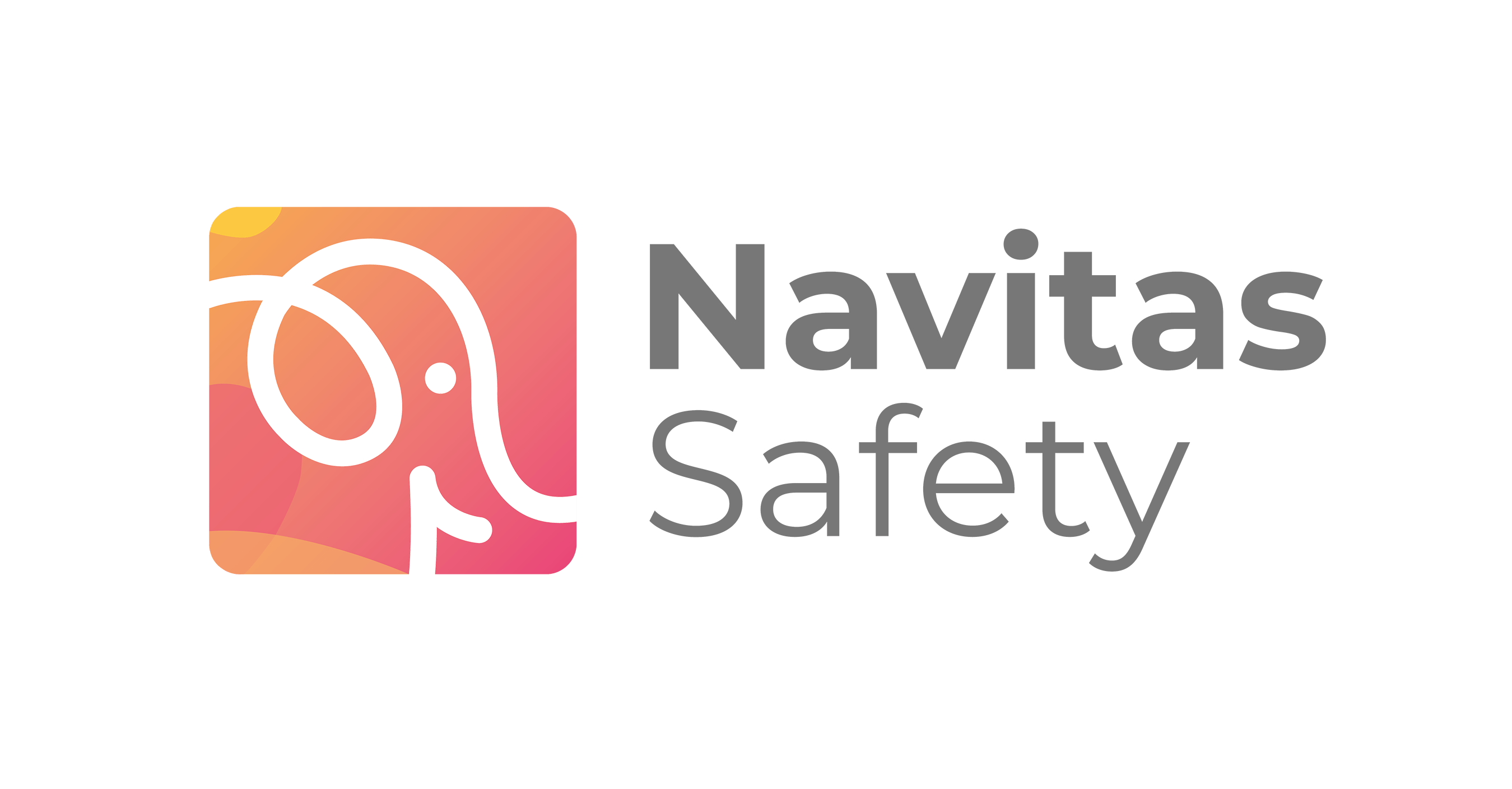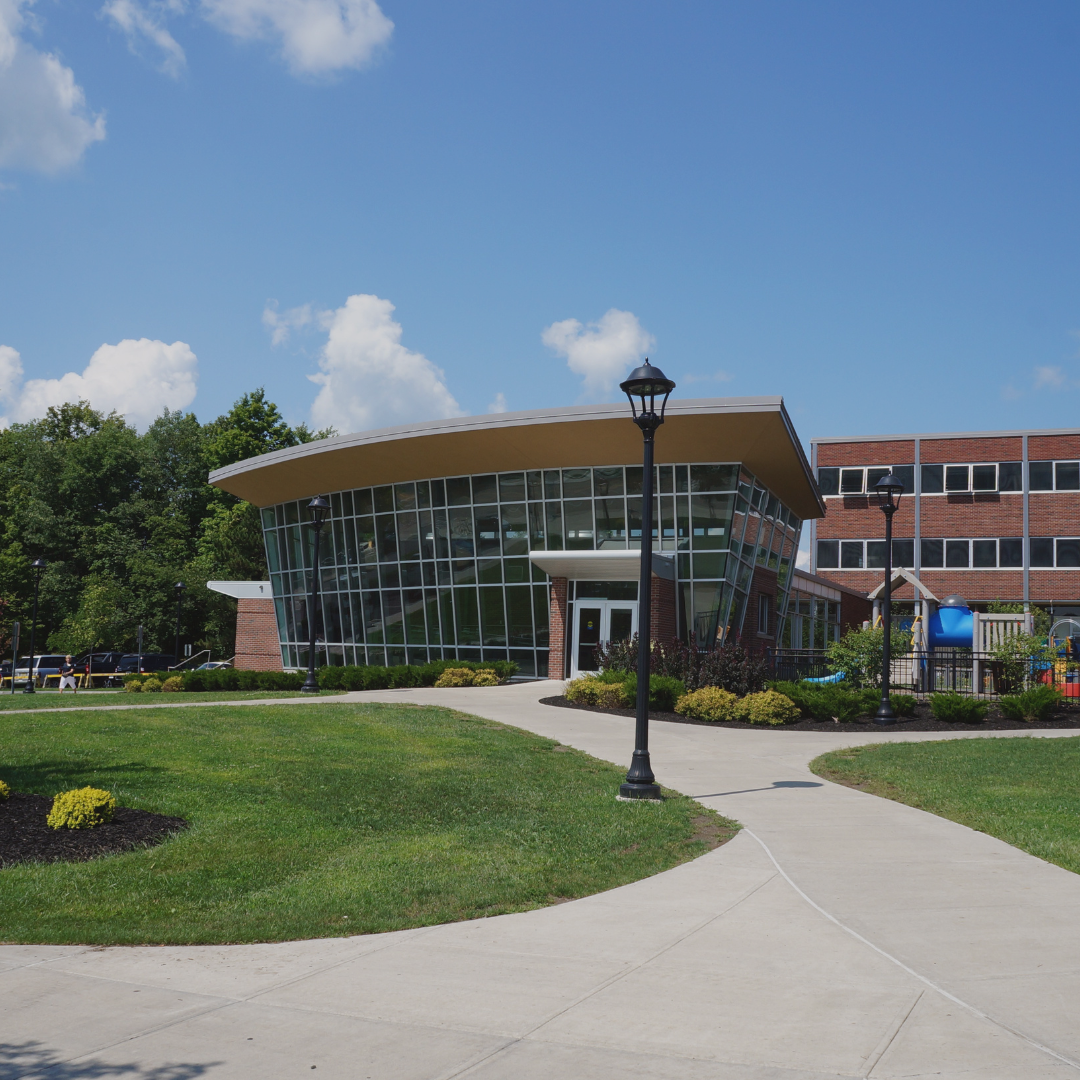Becoming a sustainable campus can be challenging. Indeed, with numerous food outlets spread across different campuses, a 360º approach to sustainability is needed. Many universities and colleges have already implemented robust sustainability plans to positively impact the environment. But have you ever considered looking into your campus food safety processes to further reduce your carbon footprint?
⅔ of universities’ carbon emissions actually originate from procurement and food safety is not considered enough as a key area of improvement for becoming a more sustainable campus. So how about new initiatives based on eco-friendly procurement to modernise your campus food safety processes? These will add some extra green power to your current environmental management strategy to become an eco campus!
This blog will take you through 3 initiatives to reduce your carbon footprint thanks to more efficient food safety processes. Read along to find out how modernising and digitising food safety can help your campus become more sustainable, while keeping your students and staff completely safe.
What we will go through
Understanding sustainability challenges in the education sector
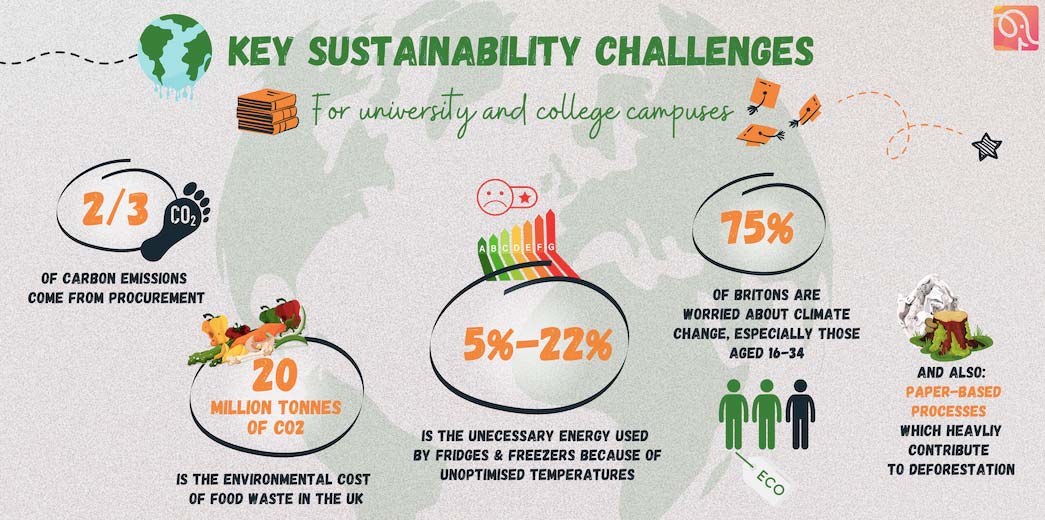
Britons aged 16-34 are the most worried about climate change
Universities, colleges, academies and schools share similar sustainability challenges, specifically with food safety processes. With increasing pressure from governments and a national mindset switching to more eco-friendly practices among young generations, sustainability is on the menu for many universities & colleges.
The University of Bristol was first in the UK to declare a climate emergency after running a survey among campus students. This isn’t surprising as 75% of adults in Great Britain worry about climate change as per a study from November 2021. In fact, the younger generations were found to be the most worried, especially those aged 16-34, coinciding with current generations of students. This therefore reinforces the importance of building a sustainable food experience and culture on campuses.
Procurement is still responsible for ⅔ of carbon emissions
Green campus initiatives already include recycling and no-plastic policies. Yet procurement remains a key area of improvement in order to sustain the growth of more sustainable campuses. Indeed, between 60 to 66% of carbon emissions are still generated by procurement, hence the need for greener options.
Food waste: still a bottleneck for sustainable campus initiatives
It’s currently estimated that ⅓ of the food produced globally goes to waste. As campuses face the challenge of multi-site structures with multiple food outlets, food waste management is even more important. Indeed, from catered halls and restaurants, all the way through to cafés, bars and events, food is a key aspect of the campus experience. While some universities, such as UCL, are already recycling 56% of their waste, food thrown away unnecessarily still remains a heavy contributor to aggravated carbon footprints. In fact, according to Food Made Good, food waste in the UK represents an annual environmental cost of 20 million tonnes of CO2.
So, can campuses further reduce food waste? Yes! Food safety is an operational area where technological changes can truly support campuses in reducing their food waste. More about this later in this blog!
Inefficient energy consumption by campus food outlets
Campuses’ multiple food outlets translate into numerous appliances to manage. Consequently, any fridge or freezer falling out of the temperature compliance range can lead to huge amounts of unnecessary food wastage.
In addition, we find that many foodservice outlets have appliances with unoptimised temperatures. In fact, they are often too cold – resulting in heavy energy bills and carbon footprints. To illustrate, we found that 1ºC cooler in your fridge could mean a 10% increase in your energy bill! So becoming an eco campus could start with a big change in the way you monitor temperatures.
Sustainable campuses fighting deforestation
Finally, let’s think about another aspect of food safety on campuses. Similarly to many industries, paperless transactions are becoming the new norm on campus. Yet, most universities and colleges still operate with paper-based processes when it comes to Food Safety and Health & Safety. Think of all the safety checklists that staff have to write, tick, sign, print, etc. That’s why switching to digital processes can support your campus in eliminating paperwork and saving trees as part of your next campus sustainability plan.
So, here are 3 initiatives to help reduce your carbon footprint and become a more sustainable campus:
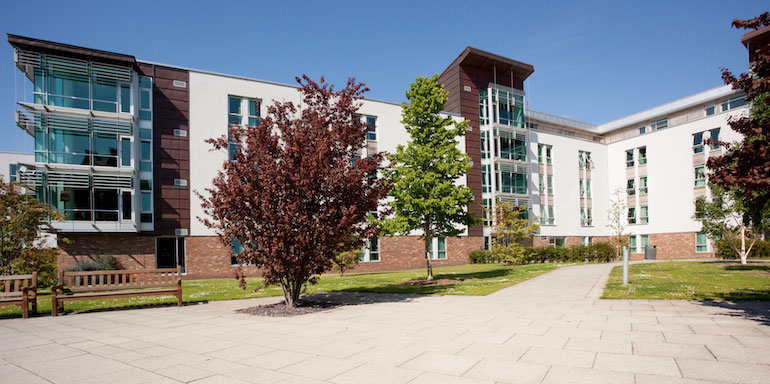
A sustainable campus starts with less paper checklists to fight deforestation 🌳
Many universities and colleges are switching to paperless transaction models and e-learning options to reduce paper use on campus. But have you ever considered the amount of paper waste generated by your campus Food Safety and Health & Safety processes?
The environmental cost of paper-based safety checklists
Our first recommended initiative would be to reduce paper use by swapping to digital processes for all things Food Safety and Health & Safety on campus. Specifically looking at checklists, campus catering teams generate an enormous amount of paper waste while running their routine safety checklists:
- Opening/closing checks;
- Daily/monthly/yearly (deep) cleaning tasks;
- Appliance temperature checklists;
- Campus recycling protocol checks;
- Event food safety tasks and many more!
Now, let’s have a look at our paper waste calculator for the education sector. But first, a bit of context! There are 32,163 schools, 142 universities and 277 colleges in the UK, as per BESA’s latest study and the Association of Colleges. We based our paper waste calculations on the commonly agreed fact that one tree can make about 10,000 sheets of paper.🌳
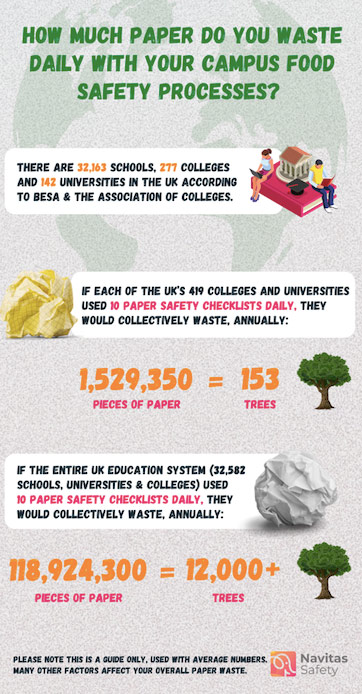
First scenario: 10 paper checklists a day by universities & colleges
If each of the UK’s 419 universities and colleges used 10 pages of paper for checklists daily, they would collectively waste 1.5+ million pieces of paper. That’s 153+ trees destroyed every year!
Second scenario: 10 paper checklists a day by the entire UK education sector
Now, let’s take into account the entire UK educational system. That is 32,582 schools, universities and colleges altogether. If each of them used 10 paper checklists a day, the collective waste would reach almost 119 million pieces of paper a year. The bad news? That’s about 12,000+ cut trees annually!
Become a sustainable campus with 100% digital safety checklists
New food safety technology helps you build more sustainable campuses and tackle environmental pressure. Our food safety software empowers you to create, customise and complete digital checklists from start to finish, for all your food outlets across multiple sites and campuses. You can choose which tasks & checks to include and their frequency too, as well as adding reminders and approval workflows.
By removing paper-based processes, you demonstrate your willingness to help fight deforestation and save trees. In addition, this will decrease your overall campus carbon footprint. Equally important, digital checklists simplify safety routine checks for campus staff, with better visibility and no more (class)room for mistakes!
Curious? Find out more about our food safety software capabilities for unlimited digital checklist functionality!
Optimised appliance temperatures for a sustainable campus 🌡
Becoming a green campus involves tackling sustainability initiatives from different operational angles, including campus catering services. Whether it’s in dining halls or campus cafés, ensuring that appliances work at optimised and eco-friendly temperatures is essential. This is where sustainable campus energy technology comes into play! And we’re not talking about the classic solar panel here! 😉
How inefficient temperatures negatively impact your campus carbon footprint
First, a little recap. Fridges should have a temperature ranging between 4 and 5ºC, while freezers should be at -18ºC. With our 33+ years of experience here at Navitas Safety, we find that many foodservice outlets have fridges and freezers operating with temperatures that are cooler than necessary (by on average 2.2ºC). Keep that in mind, because it’s commonly found that being just 1ºC cooler can actually increase your energy consumption by 5 – 10%! Most appliances nowadays have a cap, meaning that they can’t consume more than 25% extra energy. Nonetheless, even this tiny change in temperature can dramatically affect both your overall energy bill and carbon footprint.
The environmental cost of inefficient temperatures: an extra 11 tonnes of CO2!
In order to help you visualise how energy inefficiencies can seriously impact your campus sustainability goals, we’ve created a calculator. This shows the importance of efficient temperature management to lower your campus carbon footprint. For context, we have based our calculator on the following average energy consumption data in the UK:
- A single door upright fridge rated C uses, on average, 623 kWh per year;
- A 400L chest freezer uses, on average, 1,168 kWh per year;
- The average current cost of electricity in the UK is 16.3p per kWh;
- On average, we found that fridges and freezers tend to be 2.2 ºC cooler than they should.
Please note that this calculator should be used as a guide only as many other factors impact your business’ carbon footprint and appliances’ energy performance. This calculator provides an estimate into efficiencies that can be achieved through optimised temperature management.
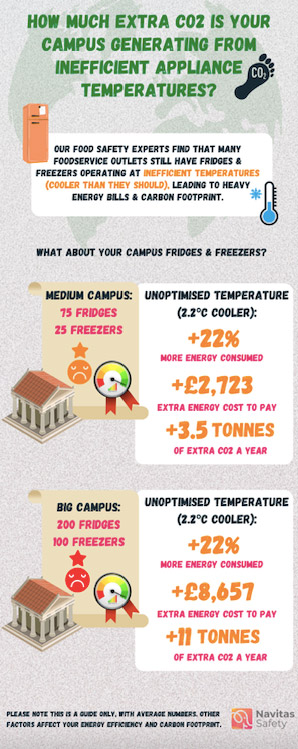
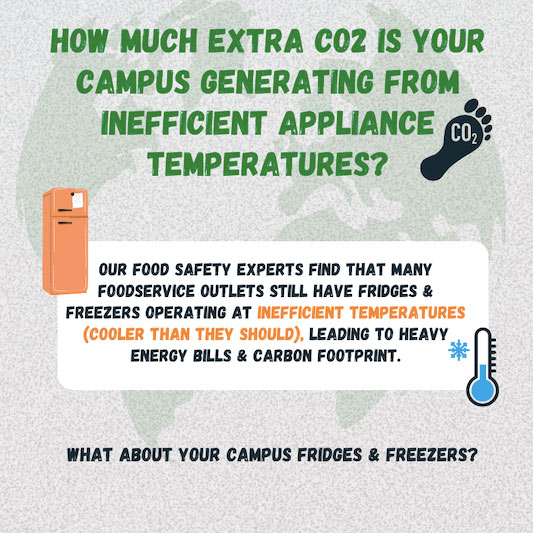
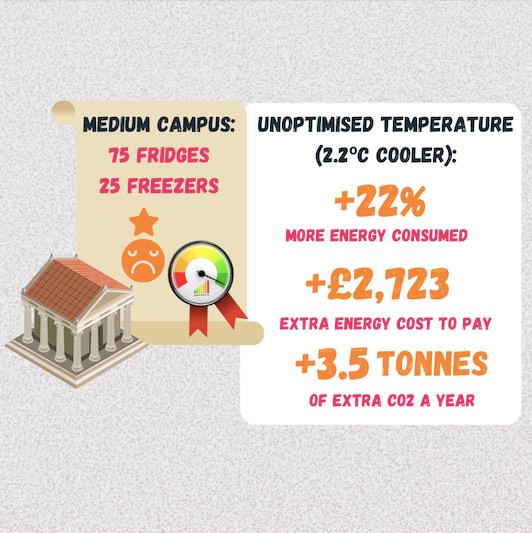
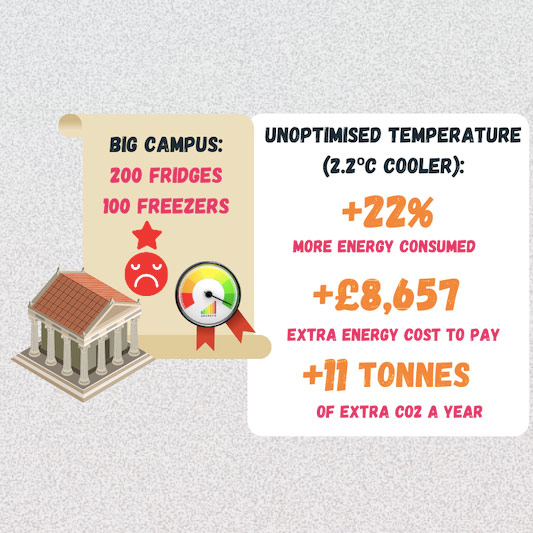
First example: a medium-sized campus
Our medium campus has 75 fridges and 25 freezers across several food outlets. Based on the above criteria, its annual energy consumption reaches about 75,925 kWh. If all appliances were running efficiently, they would spend £12,376 a year on energy. Unfortunately some appliances operate at temperatures 2.2ºC cooler than they should, resulting in a 22% increase in energy consumption. Consequently, they pay an extra £2,723, totalling £15,099 a year. In addition, that unnecessary energy consumption generates 3.5 extra tonnes of CO2e a year!
Second example: a bigger campus
Our big campus has 200 fridges and 100 freezers spread across multiple food outlets. Its energy consumption reaches about 241,400 kWh every year. If all appliances were running efficiently, they would spend £39,348 on energy, annually. But similarly to our medium campus, some appliances operate with temperatures 2.2ºC cooler than they should, resulting in a 22% increase in energy consumption. Again, this is a big hit! An extra £8,657 to pay, totalling £48,000+ a year. On top of that, this unnecessary energy consumption generates 11 extra tonnes of CO2e a year for our big campus. Not very green for a sustainable campus, right?
Use our FREE energy calculator to find out how much CO2 & money you could save on your next energy bill!
Eco-friendly temperature monitoring systems for a sustainable campus
So what can you do? Manually checking and recording appliance temperatures is time-consuming for your teams and means inefficient or non-compliant temperatures aren’t always discovered very quickly. Consequently this can lead to food wastage and other food safety problems. Plus, it uses a lot of paper!
So it’s time to introduce you to our wireless Smart Pods. Once placed in your fridges and freezers, they automatically monitor appliance temperatures to ensure optimised energy consumption 24/7. They will alert you if temperatures fall out of compliant range or aren’t eco-friendly, so that you can resolve them instantly.
This simple switch to wireless appliance sensors can significantly lower your annual energy bill and improve your carbon footprint on campus, all while prioritising food safety too! Conclusion? Digital food safety should be part of your sustainable campus initiatives! It will definitely reinforce your commitment to a reliable systemic approach in managing your environmental impact. 💚
Fancy more info about our Smart Pods?
Eliminate campus food waste to become a sustainability champion ♻️

Food waste remains a major sustainability challenge for many educational institutions. Not only does unnecessary food waste look bad on your campus footprint, but it also adds extra landfill costs! So here’s another initiative to drastically cut food waste and turn your university or college into an eco campus.
Getting to the root cause of food waste to build a sustainable campus
While many campuses already recycle a lot of their waste, we suggest you tackle the problem from the start before waste is even generated. Indeed, many universities, such as UCL, already recycle 56% of their waste and turn the rest into energy. But what if you could cut food waste from the start? That is to say, remove the possibility of even creating unnecessary food waste! In fact, a major part of unnecessary campus food waste is generated by food kept at unsafe temperatures which needs to be thrown away for safety reasons.
An automated temperature control system as a key sustainable campus initiative
So, what can you do? The latest digital food safety technology equips your campus food outlets with Smart Probes and Smart Pods.
These wireless and handy Smart Probes allow staff to easily check food temperatures with data automatically logged into the system. All food safety guidelines can be uploaded into the probes, meaning campus staff know all cooking and reheating instructions, so there’s no room for error. As a result, less food is wasted during preparation. No more undercooked chicken for students, it’s all safe and cooked to perfection. No planet B, no problem: your campus teams have Smart Probes!
Additionally, the Smart Pods will turn your campus kitchens into a simple and digital safety ecosystem with automated temperature monitoring to ensure no food is wasted in fridges and freezers. Compliant and efficient temperatures 24/7. Truly, having such a system in place plays a key part in helping you become more of a sustainable college or university.
Explore more about digital food safety kits here!
Sustainable campus: digital food safety kits as a cost-effective green solution 💚🎓
To sum up, we recommend that you explore Food Safety and Health & Safety processes as a key area of improvement to become a more sustainable campus. While recycling waste, adopting no-plastic policies and setting solar panels can help, turning your campus kitchens into green outlets will support your chances of landing a rewarding star rating from the Sustainable Restaurant Association.
In addition, digital food safety will become the star of your sustainable procurement goals by being cost-effective. It will perfectly fit within your current environmental management strategy thanks to multiple benefits:
- First, saving your teams countless hours of work with simple, digital processes; ⏰
- Second, minimising human errors in safety processes; 🚨
- Third, protecting your university’s or college’s reputation; 🔒
- Fourth, keeping your staff and students safe at all times for a 5* campus food experience; 🍽
- Fifth, supporting you in becoming a more sustainable university or college; 🌎
- Sixth, generating economies of scale across all campus sites and food outlets; 💰
- Finally, giving you a 360º view on all food safety tasks across all outlets & sites! 👁
Find out more about the sustainability benefits of digital food safety 💚
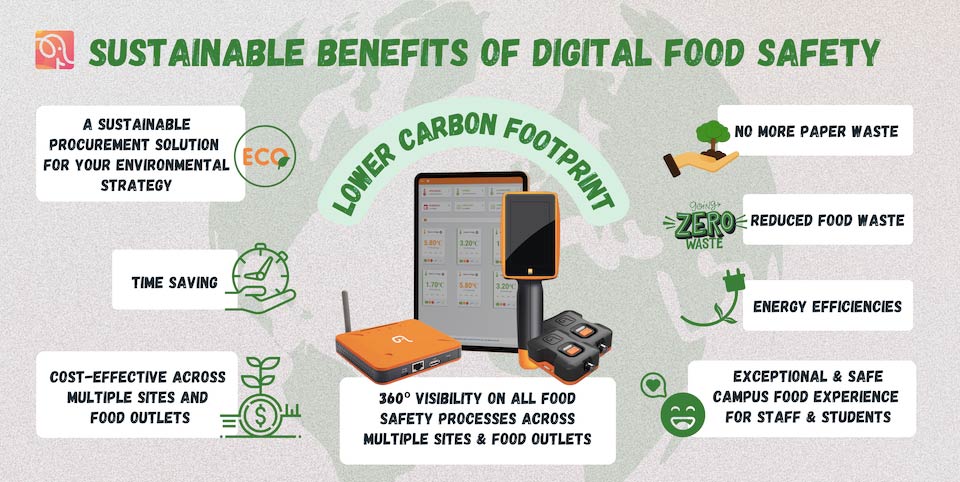
Try our digital food safety for FREE
🗓 14 days 🧡 No commitment 💳 No credit card required
✅ Outstanding food safety
Find out how much energy and CO2 you could save by switching to digital food safety processes!
Navitas Safety can work alongside your Sustainability and/or Catering teams to support you in improving your environmental credentials. We help you have a positive (and green) impact on everything you do on campus. Besides, it’s good for your brand, students, staff and the planet! We’re all in this together. 🌍
